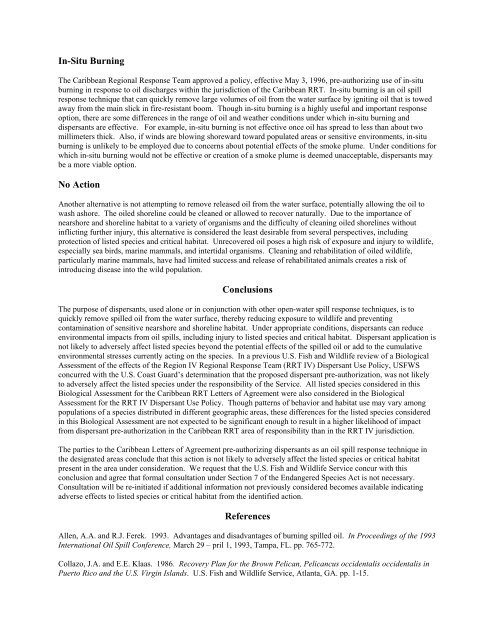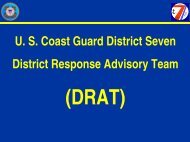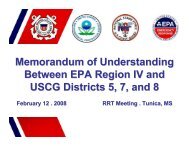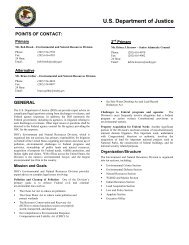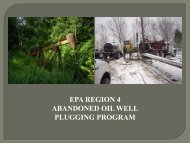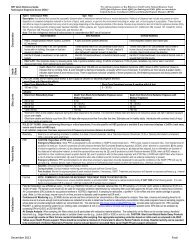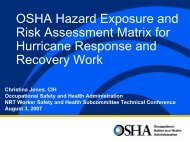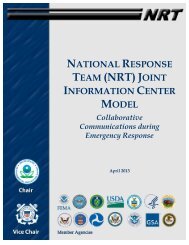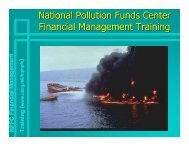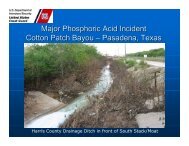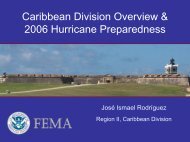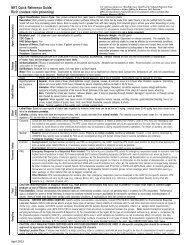USE OF DISPERSANTS - U.S. National Response Team (NRT)
USE OF DISPERSANTS - U.S. National Response Team (NRT)
USE OF DISPERSANTS - U.S. National Response Team (NRT)
- No tags were found...
You also want an ePaper? Increase the reach of your titles
YUMPU automatically turns print PDFs into web optimized ePapers that Google loves.
In-Situ BurningThe Caribbean Regional <strong>Response</strong> <strong>Team</strong> approved a policy, effective May 3, 1996, pre-authorizing use of in-situburning in response to oil discharges within the jurisdiction of the Caribbean RRT. In-situ burning is an oil spillresponse technique that can quickly remove large volumes of oil from the water surface by igniting oil that is towedaway from the main slick in fire-resistant boom. Though in-situ burning is a highly useful and important responseoption, there are some differences in the range of oil and weather conditions under which in-situ burning anddispersants are effective. For example, in-situ burning is not effective once oil has spread to less than about twomillimeters thick. Also, if winds are blowing shoreward toward populated areas or sensitive environments, in-situburning is unlikely to be employed due to concerns about potential effects of the smoke plume. Under conditions forwhich in-situ burning would not be effective or creation of a smoke plume is deemed unacceptable, dispersants maybe a more viable option.No ActionAnother alternative is not attempting to remove released oil from the water surface, potentially allowing the oil towash ashore. The oiled shoreline could be cleaned or allowed to recover naturally. Due to the importance ofnearshore and shoreline habitat to a variety of organisms and the difficulty of cleaning oiled shorelines withoutinflicting further injury, this alternative is considered the least desirable from several perspectives, includingprotection of listed species and critical habitat. Unrecovered oil poses a high risk of exposure and injury to wildlife,especially sea birds, marine mammals, and intertidal organisms. Cleaning and rehabilitation of oiled wildlife,particularly marine mammals, have had limited success and release of rehabilitated animals creates a risk ofintroducing disease into the wild population.ConclusionsThe purpose of dispersants, used alone or in conjunction with other open-water spill response techniques, is toquickly remove spilled oil from the water surface, thereby reducing exposure to wildlife and preventingcontamination of sensitive nearshore and shoreline habitat. Under appropriate conditions, dispersants can reduceenvironmental impacts from oil spills, including injury to listed species and critical habitat. Dispersant application isnot likely to adversely affect listed species beyond the potential effects of the spilled oil or add to the cumulativeenvironmental stresses currently acting on the species. In a previous U.S. Fish and Wildlife review of a BiologicalAssessment of the effects of the Region IV Regional <strong>Response</strong> <strong>Team</strong> (RRT IV) Dispersant Use Policy, USFWSconcurred with the U.S. Coast Guard’s determination that the proposed dispersant pre-authorization, was not likelyto adversely affect the listed species under the responsibility of the Service. All listed species considered in thisBiological Assessment for the Caribbean RRT Letters of Agreement were also considered in the BiologicalAssessment for the RRT IV Dispersant Use Policy. Though patterns of behavior and habitat use may vary amongpopulations of a species distributed in different geographic areas, these differences for the listed species consideredin this Biological Assessment are not expected to be significant enough to result in a higher likelihood of impactfrom dispersant pre-authorization in the Caribbean RRT area of responsibility than in the RRT IV jurisdiction.The parties to the Caribbean Letters of Agreement pre-authorizing dispersants as an oil spill response technique inthe designated areas conclude that this action is not likely to adversely affect the listed species or critical habitatpresent in the area under consideration. We request that the U.S. Fish and Wildlife Service concur with thisconclusion and agree that formal consultation under Section 7 of the Endangered Species Act is not necessary.Consultation will be re-initiated if additional information not previously considered becomes available indicatingadverse effects to listed species or critical habitat from the identified action.ReferencesAllen, A.A. and R.J. Ferek. 1993. Advantages and disadvantages of burning spilled oil. In Proceedings of the 1993International Oil Spill Conference, March 29 – pril 1, 1993, Tampa, FL. pp. 765-772.Collazo, J.A. and E.E. Klaas. 1986. Recovery Plan for the Brown Pelican, Pelicancus occidentalis occidentalis inPuerto Rico and the U.S. Virgin Islands. U.S. Fish and Wildlife Service, Atlanta, GA. pp. 1-15.


